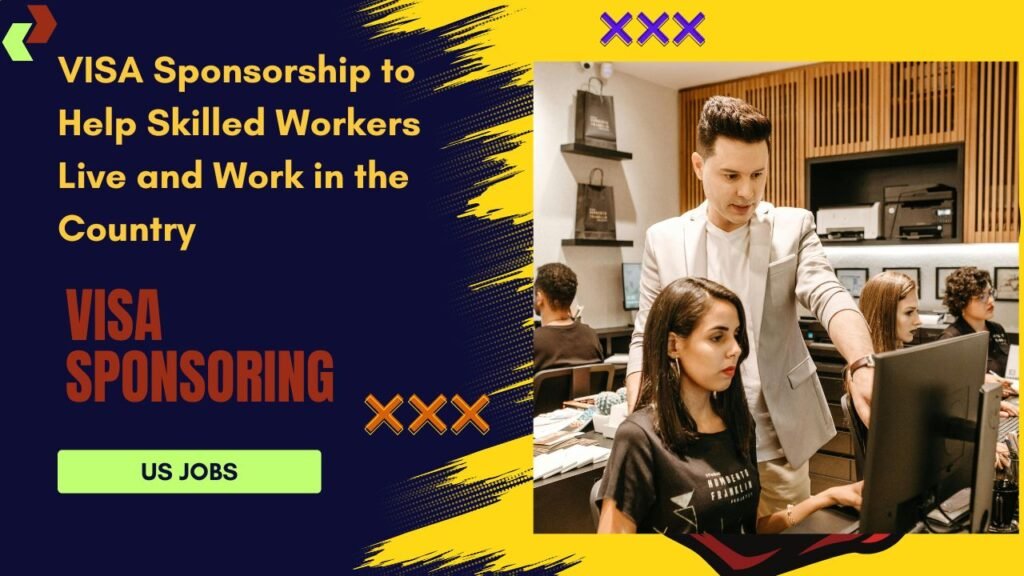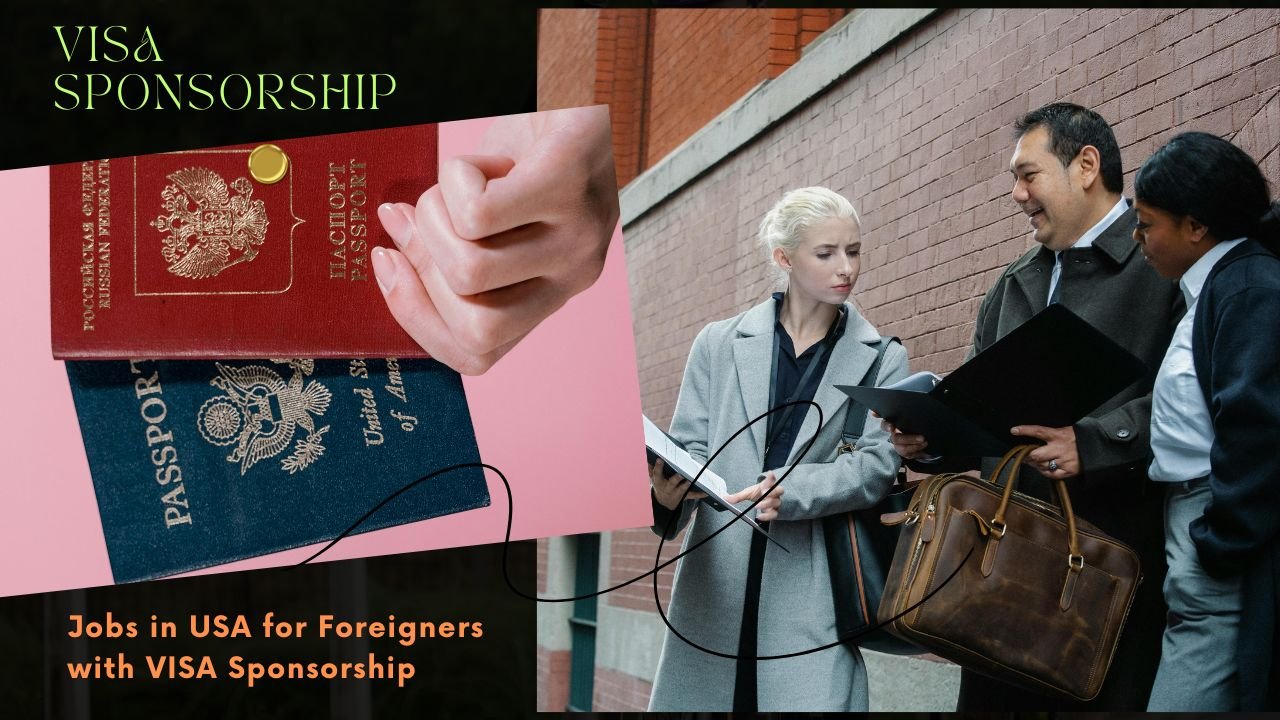Finding a job in the USA can be challenging for foreigners. Many seek opportunities that offer visa sponsorship.
This support helps them live and work legally in the country. The United States is a land of opportunity, attracting talent from around the world. Many companies are eager to hire skilled workers, even if they need visa sponsorship. This creates a pathway for foreigners to build their careers in the U.
S. Economy. Understanding the job market and the requirements for visa sponsorship is crucial. It helps candidates navigate their options effectively. In this blog post, we will explore various job opportunities available for foreigners. We will also discuss the visa sponsorship process and how it can open doors to a new life in the USA.
You May Also Like:

VISA Sponsorship Basics
Finding a job in the USA can be challenging for foreigners. Many companies offer visa sponsorship to help skilled workers live and work in the country. Understanding visa sponsorship basics is essential for anyone looking to work in the USA. This section will cover types of visas and eligibility criteria for those seeking opportunities in the American job market.
Types of VISAS
There are several types of visas available for foreigners seeking employment in the USA. Each visa serves a different purpose and has specific requirements. Here are some of the most common types:
- H-1B Visa: For skilled workers in specialty occupations. Requires a job offer and a bachelor’s degree or higher.
- L-1 Visa: For intra-company transferees. Allows companies to transfer employees from a foreign office to a U.S. office.
- O-1 Visa: For individuals with extraordinary ability in their field. This includes artists, athletes, and scientists.
- TN Visa: Available for Canadian and Mexican citizens under NAFTA. It is for specific professions like engineers and accountants.
| Visa Type | Purpose | Requirements |
|---|---|---|
| H-1B | Specialty Occupations | Job offer, bachelor’s degree |
| L-1 | Intra-company Transfer | Employment at a foreign office |
| O-1 | Extraordinary Ability | Proof of achievements in the field |
| TN | Professionals from Canada/Mexico | Job offer in a listed profession |
Choosing the right visa is crucial. Each visa type has different application processes and timelines. Foreign workers should research the specific requirements for each visa type.
Eligibility Criteria
To qualify for a visa sponsorship, applicants must meet several criteria. These requirements can vary based on the visa type but generally include:
- Job Offer: A confirmed job offer from a U.S. employer is necessary.
- Education: Applicants may need a specific level of education, usually a bachelor’s degree.
- Experience: Relevant work experience in the field is often required.
- Language Skills: Proficiency in English is usually expected.
Employers may also consider:
- Availability of U.S. workers for the position.
- The applicant’s ability to perform job duties.
Meeting these criteria is vital for a successful visa application. Each visa has its own set of guidelines, so applicants should carefully review them before applying.
Popular Job Sectors
Jobs in the USA for foreigners with visa sponsorship are abundant. Many sectors are welcoming international talent. This creates great opportunities for skilled workers. Popular job sectors include technology, healthcare, and engineering. These fields offer diverse roles and solid career paths.
Technology
The technology sector is one of the fastest-growing job markets in the USA. Companies seek skilled workers from around the world. Many tech jobs offer visa sponsorship. Fields like software development, data analysis, and cybersecurity are in high demand.
Some popular roles include:
- Software Developer
- Data Scientist
- Cybersecurity Analyst
- Cloud Engineer
- IT Support Specialist
According to the Bureau of Labor Statistics (BLS), the tech sector is expected to grow by 22% from 2020 to 2030. This growth opens many doors for foreigners. Many companies also provide training and resources for new employees.
Here’s a quick look at average salaries in the tech sector:
| Job Title | Average Salary |
|---|---|
| Software Developer | $112,620 |
| Data Scientist | $100,560 |
| Cybersecurity Analyst | $103,590 |
Healthcare
The healthcare sector is critical in the USA. Hospitals and clinics are always looking for qualified staff. This sector offers many positions with visa sponsorship. Roles in nursing, medical technology, and physical therapy are especially sought after.
Key job titles include:
- Nurse
- Medical Technologist
- Physical Therapist
- Pharmacist
- Healthcare Administrator
The demand for healthcare workers is growing due to an aging population. BLS predicts a 16% growth for healthcare jobs from 2020 to 2030. Many hospitals offer sponsorship for qualified international candidates.
Average salaries in healthcare can vary widely:
| Job Title | Average Salary |
|---|---|
| Nurse | $75,330 |
| Medical Technologist | $54,780 |
| Physical Therapist | $85,400 |
Engineering
The engineering sector is another strong area for job seekers. Companies in various fields need engineers. This includes civil, mechanical, electrical, and software engineering. Many of these positions offer visa sponsorship.
Common job titles in engineering include:
- Civil Engineer
- Mechanical Engineer
- Electrical Engineer
- Software Engineer
- Chemical Engineer
Engineering jobs are projected to grow by 6% from 2020 to 2030. This growth creates opportunities for foreign engineers. Companies often seek diverse perspectives and skills.
Average salaries in engineering vary by discipline:
| Job Title | Average Salary |
|---|---|
| Civil Engineer | $88,570 |
| Mechanical Engineer | $90,160 |
| Electrical Engineer | $100,830 |
Job Search Strategies
Finding a job in the USA as a foreigner with visa sponsorship can be challenging. Using effective job search strategies is key. These strategies help you connect with potential employers and discover job opportunities. Networking and utilizing online job portals are two important methods. They can increase your chances of success in the competitive job market.
Networking Tips
Networking plays a vital role in job searching. Building connections can open doors to opportunities. Here are some tips to enhance your networking efforts:
- Attend Industry Events: Join conferences, workshops, or seminars in your field.
- Join Professional Organizations: Become a member of groups related to your profession.
- Use Social Media: Platforms like LinkedIn are great for connecting with professionals.
- Engage in Informational Interviews: Reach out to people in your desired field for advice.
Networking is not just about finding a job. It’s about building relationships. Here is a simple table outlining key networking actions:
| Action | Description |
|---|---|
| Attend Events | Meet industry leaders and learn about job openings. |
| Join Groups | Connect with peers and share job leads. |
| Use LinkedIn | Showcase skills and connect with recruiters. |
Remember, follow up after meeting someone. A simple message can keep the connection alive. Networking can lead to job referrals and recommendations.
Online Job Portals
Online job portals are essential tools for job seekers. They provide access to thousands of job listings. Here are some popular job portals:
- Indeed
- Monster
- Glassdoor
- LinkedIn Jobs
Using these portals effectively can improve your job search. Here are some tips to maximize your use of online job portals:
- Create a Strong Profile: Highlight your skills and experiences.
- Set Job Alerts: Get notifications for new job postings.
- Customize Your Resume: Tailor your resume for each job application.
Many portals allow you to apply directly. This makes the application process easier. Take advantage of filters to narrow your search. Focus on job types that fit your skills and visa requirements.
Understanding the job market is crucial. Research companies that sponsor visas. This knowledge can guide your applications. Use online portals as a primary resource in your job search.
Resume and Application tips
Finding jobs in the USA for foreigners with visa sponsorship can be a challenging task. A strong resume and a well-written application can make a big difference. These documents are your first chance to impress employers. They need to show your skills and experience clearly. Here are some tips to help you create an effective resume and tailor your cover letters.
Crafting an Effective Resume
Your resume is your personal marketing tool. It should highlight your strengths and experience in a clear way. Keep these tips in mind:
- Keep it concise: Limit your resume to one page.
- Use clear headings: Organize your sections with bold titles.
- Focus on achievements: Highlight what you accomplished in each job.
Use the following format for your resume:
| Section | Details |
|---|---|
| Contact Information | Name, phone number, email, LinkedIn profile |
| Objective Statement | A brief statement about your career goals |
| Work Experience | List jobs with dates, company names, and key duties |
| Education | Degrees, schools, and graduation dates |
| Skills | Relevant skills like software or languages |
Make sure to proofread for errors. A mistake can hurt your chances.
Tailoring Cover Letters
Your cover letter is a chance to connect with employers. It should explain why you are a good fit for the job. Here are some tips for writing effective cover letters:
- Address the employer: Use their name if possible.
- Be specific: Mention the job title you are applying for.
- Show enthusiasm: Express your interest in the company.
Structure your cover letter like this:
- Introduction: Briefly state who you are and the position you want.
- Body: Highlight your skills and experiences. Use examples.
- Closing: Thank them for their time and express your eagerness.
Make sure to customize each cover letter. This shows you care about the job and the company.
Interview Preparation
Finding jobs in the USA for foreigners with visa sponsorship is an exciting journey. One key step in this process is interview preparation. Interviews are crucial. They give you a chance to show your skills and fit for the job. Being ready helps reduce anxiety. This section will cover common interview questions and important cultural considerations.
Common Interview Questions
Employers often ask similar questions in interviews. Knowing these questions can help you prepare. Here are some common interview questions you might face:
- Tell me about yourself.
- What are your strengths and weaknesses?
- Why do you want to work here?
- Describe a challenge you faced and how you overcame it.
- Where do you see yourself in five years?
Each question serves a purpose. They help employers understand your background and goals. Here is a brief table showing why these questions matter:
| Question | Purpose |
|---|---|
| Tell me about yourself | To understand your background |
| What are your strengths and weaknesses? | To assess self-awareness |
| Why do you want to work here? | To see your motivation |
| Describe a challenge you faced | To evaluate problem-solving skills |
| Where do you see yourself in five years? | To gauge your career goals |
Practice answering these questions. Use clear and concise language. Keep your answers focused on your skills and experiences. This practice will boost your confidence on interview day.
Cultural Considerations
Cultural differences can affect your interview experience. Understanding these differences is essential. Here are some important points to keep in mind:
- Be punctual. Arriving on time shows respect.
- Dress appropriately. Professional attire is often expected.
- Use a firm handshake. This conveys confidence.
- Maintain eye contact. It shows engagement and honesty.
- Be polite but assertive. Show that you value your opinions.
Also, be prepared for small talk. Americans often start conversations with casual topics. This is a way to build rapport. You can discuss the weather or local events. Avoid sensitive topics like politics or religion.
Understanding these cultural aspects can help you connect better with interviewers. It shows that you respect their culture. This respect can improve your chances of success.
Post-job Offer Process
Finding a job in the USA can be a life-changing experience for foreigners. Many employers offer visa sponsorship, making it easier for skilled workers to move. After receiving a job offer, a new process begins. This is the post-job offer process. It involves securing a work visa and planning for relocation. Understanding these steps is crucial for a smooth transition to life in the USA.
You May Also Like:
VISA Application Steps
After securing a job offer, the next step is the visa application process. This process can seem complex. However, breaking it down into steps can help you understand what to do. Here are the main steps involved:
- Employer Files Petition: Your employer must file a petition on your behalf. This is usually Form I-129 for H-1B visas.
- Wait for Approval: The U.S. Citizenship and Immigration Services (USCIS) reviews the petition. This can take several weeks.
- Pay Fees: Your employer usually pays the filing fees. Some fees might be your responsibility.
- Receive Approval Notice: If approved, you will get a Form I-797. This is your approval notice.
- Apply for Visa: With the approval notice, you can apply for a visa at a U.S. consulate. Fill out Form DS-160.
- Schedule an Interview: After submitting the application, schedule an interview at the consulate.
- Attend the Interview: Bring required documents to the interview, such as your job offer letter and financial documents.
Here is a summary table of the visa application steps:
| Step | Description |
|---|---|
| 1 | Employer files petition |
| 2 | Wait for approval |
| 3 | Pay fees |
| 4 | Receive approval notice |
| 5 | Apply for visa |
| 6 | Schedule an interview |
| 7 | Attend the interview |
Relocation Considerations
Relocating to the USA involves many important factors. Planning ahead can reduce stress. Here are key considerations for your move:
- Housing: Find a suitable place to live. Research neighborhoods and consider rental costs.
- Cost of Living: Understand the cost of living in your new city. This includes groceries, utilities, and transportation.
- Health Insurance: Ensure you have health insurance. Check if your employer provides coverage.
- Banking: Open a U.S. bank account. This will make managing your finances easier.
- Cultural Adjustment: Prepare for cultural differences. Connect with local communities for support.
- Transportation: Decide if you need a car. Research public transport options in your area.
Consider this checklist before moving:
| Consideration | Details |
|---|---|
| Housing | Research neighborhoods and rental costs |
| Cost of Living | Understand expenses in your new city |
| Health Insurance | Ensure coverage through employer or private plans |
| Banking | Open a U.S. bank account for easier transactions |
| Cultural Adjustment | Connect with local communities for support |
| Transportation | Research public transport or decide on a car |
Long-term Residency Options
Jobs in the USA attract many foreigners seeking new opportunities. Visa sponsorship makes it possible for them to work legally. Long-term residency options are a key consideration for those planning to stay. Many foreigners aim for stability and security. Understanding how to achieve this can lead to a fulfilling life in the USA.
Green Card Pathways
The Green Card is a vital step towards long-term residency in the USA. It allows foreigners to live and work permanently. There are several pathways to obtain a Green Card:
- Employment-Based Green Card: For those with job offers from US employers.
- Family-Sponsored Green Card: For family members of US citizens or permanent residents.
- Asylum or Refugee Status: For those fleeing persecution.
- Diversity Visa Lottery: A program for individuals from underrepresented countries.
Each pathway has specific requirements. Here’s a brief overview of the employment-based Green Card process:
| Step | Description |
|---|---|
| 1 | Find a job with a US employer. |
| 2 | Employer files a labor certification. |
| 3 | Employer submits Form I-140. |
| 4 | Applicant applies for the Green Card. |
Understanding these steps is crucial for foreigners aiming for long-term residency.
Permanent Residency Benefits
Permanently residing in the USA offers numerous advantages. Holding a Green Card provides access to various benefits:
- Job Flexibility: Green Card holders can work for any employer.
- Access to Social Security: Eligible for Social Security benefits.
- Path to Citizenship: Green Card holders can apply for citizenship after a set period.
- Family Sponsorship: Ability to sponsor family members for Green Cards.
Permanent residents enjoy rights similar to US citizens:
- Right to live anywhere in the USA.
- Ability to travel freely in and out of the country.
- Access to education and health care.
These benefits contribute to a stable and secure life in the USA. Permanent residency is a valuable goal for many foreigners.
Conclusion
Finding jobs in the USA with visa sponsorship is possible. Many companies welcome foreign workers. Research industries that often hire international talent. Networking can open doors to new opportunities. Prepare a strong resume and cover letter. Be ready for interviews and showcase your skills.
Follow job boards that specialize in sponsorship. Stay persistent in your job search. With effort and determination, you can secure a position in the USA. Your dream job is within reach. Keep pushing forward and stay hopeful.

